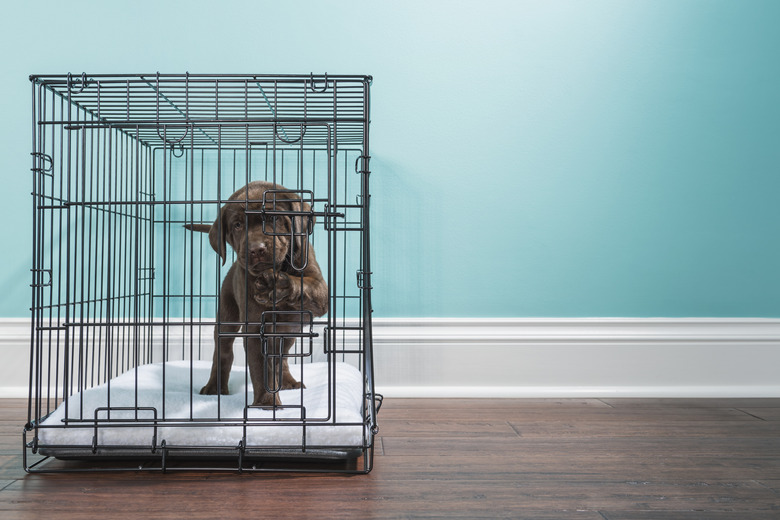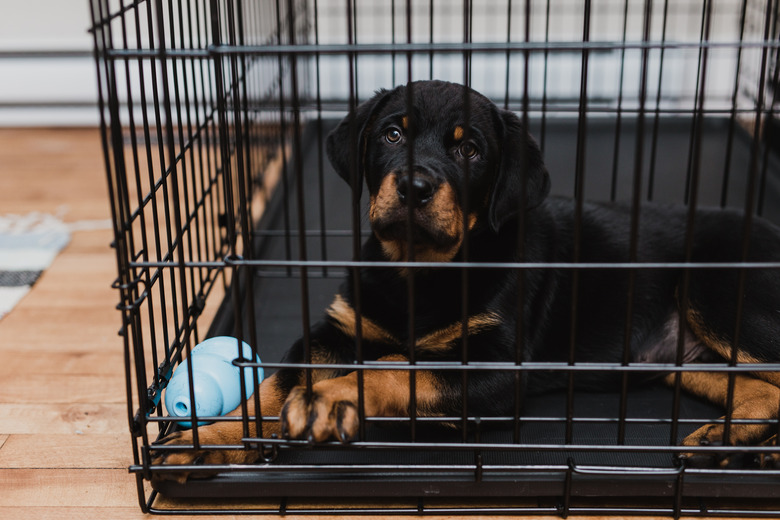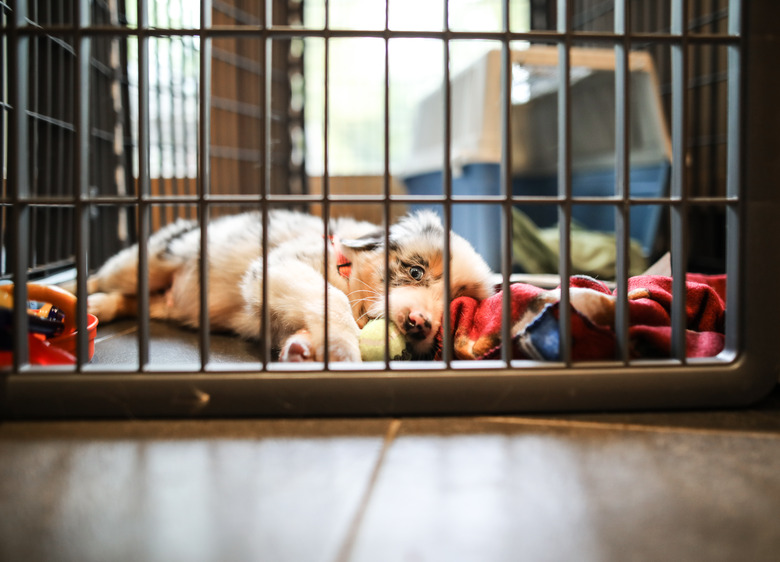How To Crate Train My 5-Month-Old Puppy
Crate training a dog prevents damage to the home from chewing while the owner is away. Dogs have a natural instinct to find a sleeping den in the wild and to a properly trained dog, a crate becomes not a cage, but a den. Since dogs instinctively avoid eliminating in their dens, it helps house train the puppy. Leaving the dog out of the crate at night is an option, but you may wake up to an accident. For best results, begin crate training as soon as possible after the puppy's weaning, but even a 5-month-old puppy can benefit from crate training.
1. Select a crate
Choose a crate large enough that your dog, when grown, will be able to stand up and turn around in with room for a water dish. The crate will be larger than what your 5-month old puppy needs right now. If there's too much excess room in the crate, the puppy can potty in one end and still eat and sleep in the other, so add a partition to the crate to allow him only the room he needs at his current size. Some crates come with a partition grate to install. If yours doesn't, create a partition using a piece of wood or plastic secured to the crate's frame with twist ties or wire.
2. Prepare the crate
Place the puppy's crate in a living room or other common area where she won't be ostracized from the family and will be able to hear the noises of the household while she's in it. Position the crate away from furniture or cabinets that she could reach with her paw. Place a small pillow and a fleece blanket in the crate that your puppy can us for sleeping once she becomes more comfortable.
3. Feed your puppy
Use the crate for your dog's feeding times twice per day when you can directly supervise him. Begin closing the door for up to two minutes, but open the door before he finishes his meal. Taking food in the crate and getting praise helps your puppy form a positive association to the crate. A 5-month-old puppy is in the "Flight Instinct Period" where he wants to test his limits and find some independence. Consistently praising your puppy for desired behavior during this stage helps him learn to please.
4. Increase crate time
Increase the amount of time your puppy spends in the crate with the door shut by a few seconds each time. Don't open the crate door if the puppy is whining or scratching. If she does start whining, wait until she has calmed down. Opening the crate door while the dog is displaying anxious or problematic behavior reinforces that behavior. For extreme anxiety and behavior issues, take your puppy to the vet and ask for advice from a behavioral specialist.
Because a 5-month-old puppy instinctually begins chewing to help with the teething that occurs during this period, guard against unintentionally reinforcing anxious chewing to prevent a long-lasting destructive behavior.
5. Offer additional rewards
Begin giving your puppy treats and toys as an incentive to go into the crate when it's not mealtime. Praise your puppy for going into the crate and stay in the room with your puppy when you close the door. Increase the time your puppy spends in the crate gradually while you stay in the room.
6. Step out of sight
Leave the room while your puppy is in the crate after he begins getting more comfortable spending some time in the crate while you are there. Stay where you can hear the puppy. Return to the room after about 15 minutes and open the crate only when and if he is not whining or scratching. Gradually increase the time you spend away from the room where your puppy's crate is located.
7. Leave the puppy alone
Leave the house for short errands that take up to only a couple of hours while your puppy is in the crate. When you return, allow your puppy to stay in the crate for a short time before taking her out, remembering not to take her out of the crate while she is whining, scratching or anxious.
8. Finish crate training
Gradually increase the amount of time you are away from home while your puppy is in the crate. Because a 5-month-old puppy has not reached full maturity, it won't be possible for her to last all day in the crate without eliminating. Allowing her to eliminate in the crate can delay house training. Plan a lunch break in your workday to walk your puppy or hire a dog walker. After your puppy is about 1 to 3 years old, he may be able to stay in a crate throughout the workday.
Things Needed
-
Crate
-
Treats
-
Durable toys
-
Dog pillow and blanket


